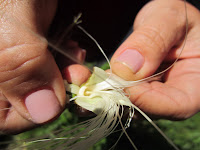Let's put things into geographical perspective: the Brazilian state of São Paolo is located in the southeasterly part of the country.
It's not quite as wet and humid as the Amazon, but it is known for it's great beaches and phenomenal Atlantic dry forest. Of course, when they say dry, it's only with respect to the Amazonian rain forest.
São Paolo's most famous city, Rio de Jeneiro, sits right along the Atlantic coast and will play host to both the
2016 Summer Olympics as well as some of the games of the
2014 FIFA World Cup.

Taubaté is located 2 hours northeast of São Paolo state's biggest city, which is creatively named São Paolo. Like São Paolo (the city), Taubaté is land-locked and relatively dry.
Ubatuba, a renowned beach vacation destination, is located a winding 2 hour drive southeast of Taubaté and just east of the Serro do Mar mountains.
 |
Inga spp. This variety is apparently found
only at elevations above 1500 m. |
While we snaked our way through the
Serro do Mar State Park, Cecilia stopped to point out a few of the local hummingbirds' favorite flowers. The first was the Inga (
Inga spp.). This flower made me think of what Beaker's hair might look like after a particularly frightening Dr. Bunson Honeydew experiment. Cecilia explained that hummingbirds love this tree because the flowers produce such huge volumes of nectar.

 |
| Fuchsia spp. |
Next, we saw the familiar fuchsia. Of course, this ain't your mama's fuchsia, dangling over the sides of a small hanging basket on the patio. This plant reached at least 50 feet up into the canopy. I was surprised that these wild flowers were just as audaciously colored as the cultivated varieties I remembered. I am proud to say that, for the first time, I resisted the urge to pop open the immature flower buds as I had done so often to my mom's plants (sorry Mom).
Now, when I say Ubatuba is “just east of the Serro do Mar mountains”, I mean, “a precipitous, harrowing drop from the mountains straight toward the Atlantic Ocean.” Signs advise drivers to descend the switchback roads in 1st or 2nd gear only. But, in reality, you'll still have to use your brakes.

I could swear I heard Click and Clack groaning in sympathy along with the whine of the engine of our official UNITAU early 2000s
VW Gol as we made the descent.
But, my white knuckles were worth the view during our drive.
The UNITAU research station is a humble little operation. But, the location couldn't be better. It's in the middle of the tourist area and right on the beach. The bed seems comfortable enough. So, I'll head off to bed and get ready for some hummingbirds tomorrow.






























